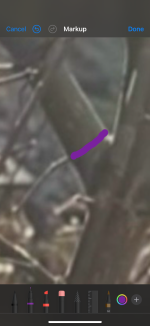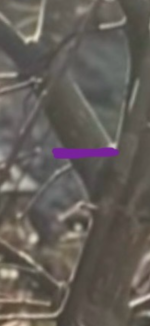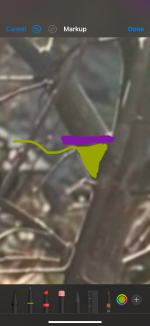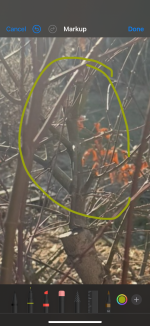Out of curiosity, Is it possible to prune back a branch on an angle so that it is cut back to the trunk on one side? Attached is a JM whose branch has gotten too thick and needs to be pruned off. So I was wondering if I could just cut it on an angle past the lowest node and just start the branch anew from there.
You are using an out of date browser. It may not display this or other websites correctly.
You should upgrade or use an alternative browser.
You should upgrade or use an alternative browser.
Cutting branches on angle to trunk
- Thread starter dbonsaiw
- Start date
SeanS
Omono
- Messages
- 1,645
- Reaction score
- 5,564
- USDA Zone
- 9b
I’m not sure I’m following. Your photo looks like a normal perpendicular (to the branch direction) cut?
I’d say yes there’s nothing wrong with cutting like in your pic. Hopefully some new buds will pop at the branch collar where it meets the trunks.
Why not give it a try and see what happens? Worst case you won’t get anything new growing and you’ll just cut the stub flush and let it heal. The branch was too thick as you said anyway so ideally you’d want to remove it anyway.
Sometimes it’s good to just go with your gut and do what you have in mind.
I’d say yes there’s nothing wrong with cutting like in your pic. Hopefully some new buds will pop at the branch collar where it meets the trunks.
Why not give it a try and see what happens? Worst case you won’t get anything new growing and you’ll just cut the stub flush and let it heal. The branch was too thick as you said anyway so ideally you’d want to remove it anyway.
Sometimes it’s good to just go with your gut and do what you have in mind.
My pic wasn’t great. What I was considering was cutting on an angle at the little lower shoot with the top cut past the node. Maybe this pic is better. Rather than cutting straight above the node (which would leave a big stub) I would cut on an angle thereby removing the part of the node above the cut (which would presumably die back to the trunk). That would leave a smaller, triangular stub and I would continue the branch from there. No idea what that produces and I’m more than happy to simply prune off the branch in its entirety, but still curious.
Attachments
SeanS
Omono
- Messages
- 1,645
- Reaction score
- 5,564
- USDA Zone
- 9b
Are you asking if it’s physically possible? Would it cause die back? Is it acceptable in bonsai design? Not sure what the question is 

I guess I’m asking if that’s an acceptable bonsai development technique or will it just produce something unsightly. At first thought at least, it seems like it would create a smaller, bent nub of a branch (but I have no idea).Are you asking if it’s physically possible? Would it cause die back? Is it acceptable in bonsai design? Not sure what the question is
This whole bonsai thing feels like two steps forward and then a few steps back sometimes. The genesis of the question came from me reconsidering the front and planting angle of the attached JM. The part that would now be the new section of trunk (the circled section) has fat branches that need to go. That section however still has a fair amount of fattening to do. I assume I don’t need the fat side branches for that and can accomplish the fattening by letting the leader run for some time. There are already some shoots at the base of the branch that can use.
Attachments
19Mateo83
Masterpiece
As long as you leave the branch collar you should get budding from the cut site.
Gabler
Masterpiece
I did that with a ficus and it worked, but that's a ficus, not a maple.
Good to know. Thanks. Here, I’m better off just pruning off the branch.I did that with a ficus and it worked, but that's a ficus, not a maple.
Deep Sea Diver
Imperial Masterpiece
Given a hardwood, like a maple, the cut will eventually die back to the collar no matter the cut angle… given sufficient room is left between the cut branch and the collar.
Later one follows up and removes the stub, no matter the shape of the cut edge. The only danger I see in one of your diagrams is not leaving enough room for die back..
Cheers
DSD sends
Later one follows up and removes the stub, no matter the shape of the cut edge. The only danger I see in one of your diagrams is not leaving enough room for die back..
Cheers
DSD sends
Empty Mountain
Mame
I would make a cut below the "lowest" visible bud leaving a stub and wait to see if anything buds out right from the branch collar where the branch originates from the trunk. Then you can bud select and restart your branch maybe.
namnhi
Masterpiece
You should get a load of buds from the collar after you cut that branch. That's what JM do.
Shibui
Imperial Masterpiece
This is correct.Given a hardwood, like a maple, the cut will eventually die back to the collar no matter the cut angle
It doesn't happen like the virt in post #3 unless there happens to be a node in that tiny triangle of branch that's left or an existing side shoot that isn't shown in any of the drawings. More usually buds emerge from the old node that the branch originally grew from AKA branch collar and the remains of the branch dies back to the new shoots or to the trunk. IMHO you will eventually have to cut back flush anyhow.
Remember that any growth thickens the entire trunk below it. Letting a leader grow thickens the trunk but it thickens pretty evenly all the way down ie very little taper. Lower sacrifice branches thicken the trunk below which makes that section thicker than above ie adds taper to the trunk.That section however still has a fair amount of fattening to do. I assume I don’t need the fat side branches for that and can accomplish the fattening by letting the leader run for some time.
It may be a much better option for the tree shown to chop the upper trunk and thick branch while leaving the other side branch as a new leader. This would add taper and also another bend in the developing trunk. That's already been done at the junction below the circle in that picture.
Very astute observation. Hopefully it's 2 forward and only 1 back if you understand and apply the correct techniques so you are still making headway. The early stages of development seem to be the most frustrating and slowest. As the trees develop progress seems to speed up so hang in there.This whole bonsai thing feels like two steps forward and then a few steps back sometimes.
LOL, thanks to all for the responses. It was more of a hypothetical question - I understand now that cutting on that angle is not recommended. If you look at the pics, there are small shoots already growing at the base of where I would prune back, so all is good on this front
At this point in my bonsai journey, I am somewhat less concerned at the pace of the development as much as I am about trying to make sure I am moving forward with a given tree. After 4 years of bonsai, I am kind of embarrassed to say to that I cannot always discern if I am actually moving forward. The wonkiness of a tree in development can make it difficult for a newbie to fully understand the material, possible next steps and how to get there. FWIW, P Afra has really helped me in this regard. The fact that it is so fast growing makes it easier to experiment with taper, movement and canopy construction. I can see more of the development process in a much shorter timespan and then attempt to apply what I learned to more conventional bonsai species. I also seem to have much less fear of failure with the P Afra so there is more freedom to just try stuff. Obviously, a P Afra isn't a JM, but a silhouette is a silhouette.Hopefully it's 2 forward and only 1 back if you understand and apply the correct techniques so you are still making headway. The early stages of development seem to be the most frustrating and slowest. As the trees develop progress seems to speed up so hang in there.
Shibui
Imperial Masterpiece
Totally agree. And you are not on your own here. Spare a thought for someone trying to make sense of bonsai techniques 40 years ago. No internet for reference, no clubs or other growers nearby. Just the Sunset Book Of Bonsai as a guide. Often it would take a year or 2, when outcomes were not as expected, to realise I'd misinterpreted the concepts and had to go back and start again... and again.At this point in my bonsai journey, I am somewhat less concerned at the pace of the development as much as I am about trying to make sure I am moving forward with a given tree. After 4 years of bonsai, I am kind of embarrassed to say to that I cannot always discern if I am actually moving forward. The wonkiness of a tree in development can make it difficult for a newbie to fully understand the material, possible next steps and how to get there.
The first years are definitely slow, not only to understand the concepts and techniques but trees also seem to react more slowly in the early years. Development pace begins to accelerate after a few years and, suddenly there's a bonsai. Just dig in and keep going.
Yeah, that’s wild. Without the internet this would be 1000x more complicated.Spare a thought for someone trying to make sense of bonsai techniques 40 years ago. No internet for reference, no clubs or other growers nearby.
Similar threads
- Replies
- 3
- Views
- 237




